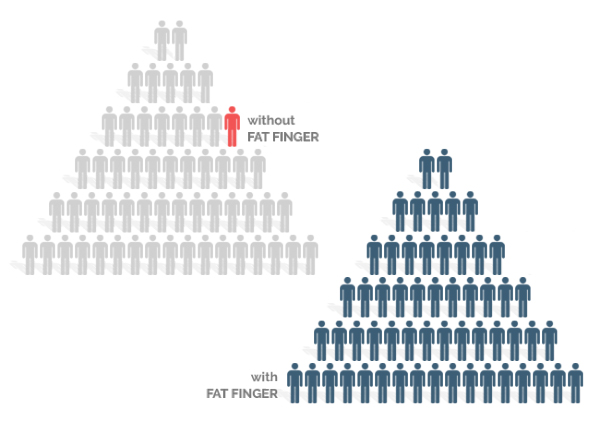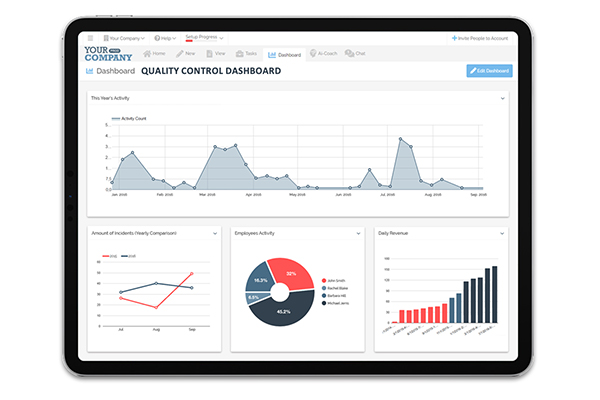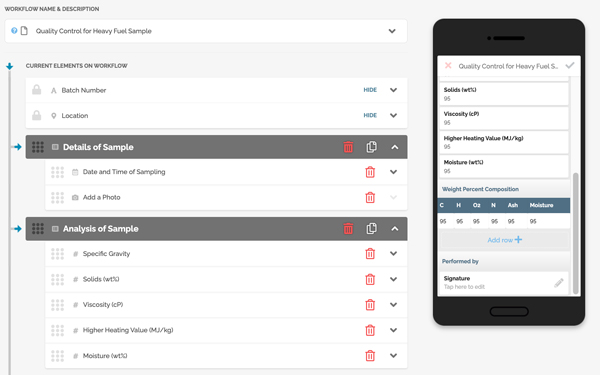Do your frontline workers do their jobs correctly and safely every time?
If you can’t confirm this objectively, then you don’t have a streamlined production process and are at risk of costly manufacturing failures, including defective products and wasted resources.
As such, a robust quality control system is necessary to ensure quality at each stage of the production process and this involves quality checklists.
They provide for manufacturers with inspection criteria for ensuring quality at each stage of the production process, from the raw materials stage to the final packaging and shipping.
But the tricky part is the number of checklists required for a large manufacturing company, the size of the workforce, and their ability to communicate effectively and track progress.
That’s where digital solutions such as FAT FINGER take over.
This application steps it up by unifying all the quality identifiers of each production stage in one easy-to-follow platform. This facilitates real-time workflow monitoring and easy collaboration between teams, especially during shift changes.
We’ve gathered more information on implementing quality control checklists in a manufacturing facility with specific examples for each stage of the production process. As we go over these ideas, you’ll learn:
- The intricacies of the production process
- How to develop your quality control checklist
- How to implement the quality control checklist
- How to monitor and report on checklist effectiveness
- The nuances of continuous improvement for quality checklists
Section 1: Understanding the Production Process
To effectively implement a quality control checklist, one needs a clear understanding of the production process, from the intake of raw materials to the distribution of finished products to your customers.
This comprehension enables a more intimate implementation of the checklist to ensure safety, quality, and consistency at every stage of the production process, for example:
- Quality of the raw materials at the material handling stage
- Safe functioning of the equipment at the production line setup
- Zero delays throughout the product assembly stage
- Effectiveness of the testing and inspection stage
- Timeliness at the packaging and shipping stage
Each of these stages contributes to the overall quality of the finished product and implementing a quality control checklist helps minimize production failures such as defects, production delays, customer dissatisfaction, and late deliveries.
Another potential application for a quality control checklist can be monitoring your frontline workers.
It helps you determine objectively whether your workers are following the established operating procedures and conducting thorough inspections of the finished goods before shipping them.
Take a possible scenario where a customer reports a defective product. All you need to do is check the product’s production date and the checklist records for a clear picture of the workflow.
And with a digitized solution such as FAT FINGER, the enterprise-grade software, this isn’t a problem because of the level of detail captured during operations. This includes batch numbers, images, defect sheets, worker comments, and stipulated procedures.
In this instance of a customer-reported defect, the FAT FINGER app tells you:
- What the defects sheet indicates for the batch that includes the customer-reported product
- Equipment report for that specific production date
- Your workers’ comments on the product batch and the equipment
Such insights give a clear perspective of your workers’ compliance and contribute to the manufacturing process improvement by highlighting the need for policy changes and training.
In a nutshell, implementing a comprehensive quality control checklist helps manufacturers identify potential issues faster and address them before they become major problems, for instance, product recalls and lawsuits.
Why This Matters: Without a clear understanding of the production process, manufacturers cannot implement effective quality control checklists.
Section 2: Developing a Quality Control Checklist

With an understanding of how a quality control checklist drives operational excellence, how do you develop one?
What are the necessary inclusions to ensure checklist optimization?
Start by identifying the production steps outlined in the section above, from material handling to packaging and shipping.
For each step, list the critical checks needed to ensure the quality of finished goods and all the foreseeable manufacturing scenarios your checklist will need to handle, such as supplier replacement.
This makes your checklist comprehensive and dynamic, enabling you to update and modify it where necessary to guarantee quality finished goods.
The following are examples of items that need to feature in a comprehensive quality control checklist at different production stages:
Example 1. Raw Materials Check
The quality of the final products depends on the quality of your raw materials. Featuring these steps in your quality control checklist helps you ensure that they’re always up to the necessary standards:
- Supplier Evaluation: Assess and select reliable suppliers based on their reputation and certifications such as the International Organization for Standardization (ISO) certificate.
This is an international seal of approval from a third-party institution verifying your supplier’s adherence to quality standards and general reliability.
- Material Specifications: Clearly define and document the required specifications for your raw materials, such as dimensions, material type, and performance characteristics, for each raw material used in the production process.
This aids in the next step in your checklist, incoming inspection.
- Incoming Inspection: Upon receiving your raw materials, conduct a thorough inspection to verify that they meet the established specifications and check for any visible defects, damages, or inconsistencies.
An automation tool such as FAT FINGER makes this step faster and easier with its identification tagging system that captures photo evidence of defective raw materials, enabling you to instantly share them with your supplier for prompt replacements.
The tool will also automatically generate reports and insights based on machine learning for manufacturing on the frequency of rejections for decision-making support, such as whether to replace a supplier.
- Material Testing: Perform material tests, such as strength, composition, and purity analysis, to ensure the raw materials comply with the desired quality requirements for an acceptable standard of finished goods.
This step also allows you to make adjustments to your material specifications for future orders.
- Storage and Handling: Were the raw materials stored in a proper and controlled environment? Were they protected from contamination, damage, and deterioration?
Include proper handling procedures in your checklist to maintain the material quality during transport and movement within the facility.
- Traceability: Assign unique identification numbers or barcodes to raw materials, enabling traceability throughout the production process and ensuring proper usage and accountability.
In this instance, the FAT FINGER app takes it up a notch with quick response (QR) codes capable of capturing much more information on your assets than simple barcodes.
From their physical location to census to the handlers responsible and their pending instructions. All the data is consolidated within the QR code and accessible via a quick scan.
Example 2. Equipment Calibration Check
Proper equipment calibration helps a manufacturing facility maintain accurate and consistent measurements during operations, which minimizes product defects and facilitates high-quality products.
Incorporate the following steps into your quality control checklist to ensure all equipment is calibrated correctly:
- Identify Key Equipment: List all the essential equipment used in the manufacturing process that requires calibration, such as measuring devices, production machinery, and testing equipment.
- Set Calibration Standards: Determine the required calibration standards for each piece of equipment based on the manufacturer’s guidelines, industry standards, and regulatory requirements, and include them on your checklist.
- Establish Calibration Frequencies: Define the frequency at which each piece of equipment should be calibrated, considering factors like usage, criticality, and historical performance data.
Calibration frequencies can range from daily, weekly, or monthly to yearly, depending on the equipment’s significance and stability.
- Assign Responsibilities: Designate a responsible person or team for equipment calibration tasks, such as in-house technicians, maintenance personnel, or external calibration service providers.
- Document Procedures: Develop detailed calibration procedures that include step-by-step instructions, required tools and equipment, and acceptance criteria. Ensure that the calibration procedures are readily available for reference.
- Maintain Calibration Records: Keep accurate and up-to-date records of all calibration activities, including equipment details, calibration dates, results, and any corrective actions taken.
These records help in tracking equipment performance and identifying potential issues.
- Monitor Equipment Performance: Regularly review the calibration records and equipment performance data to detect any deviations or trends that may indicate issues with the equipment or calibration process.
- Implement Corrective Actions: In case of calibration failures or equipment malfunctions, promptly implement corrective actions, such as repairing or replacing the equipment, adjusting calibration procedures, or retraining personnel.
Example 3. Measurements Check
Accurate and precise measurements are critical quality control procedures in a manufacturing facility.
By closely monitoring and verifying measurements throughout the production process, manufacturers can minimize errors and defects, resulting in a higher-quality end product.
The following components need to be included in a comprehensive quality control checklist for measurements:
- Calibration of Measuring Equipment: Regularly calibrate measuring equipment such as scales, gauges, and meters to ensure their accuracy and reliability.
This should be done according to the manufacturer’s recommendations or industry standards from a governing authority, which serve as a universal measure of quality.
- Measurement Procedures: Establish and document standardized procedures for taking measurements throughout the production process.
This will ensure that all employees are using consistent methods and techniques, reducing the likelihood of measurement errors.
- Measurement Verification: Conduct periodic checks of measurements taken during the production process to verify their accuracy.
These checks should be carried out by a designated quality control inspector or another qualified employee.
- Measurement Tolerances: Clearly define acceptable tolerances for measurements at each stage of the production process.
This will help employees understand the allowable margin of error and ensure that measurements stay within specified limits.
- Employee Training: Provide ongoing training for employees on proper measurement techniques and the importance of accurate measurements in maintaining product quality.
This helps ensure that all team members understand the significance of their role in the quality control process and encourages compliance.
The FAT FINGER app offers real-time coaching to frontline staff with suggestions on the standard operating procedures to follow.
Take the instance where a worker is checking the pressure measurements of a piece of equipment and records a suboptimal value.
The app will note this error with a statement such as ”The pressure recorded is too high. Turn down the compressor and contact your supervisor immediately.”
This real-time feedback encourages compliance from your frontline staff while preventing potentially costly damages.
- Record-Keeping: Maintain accurate and up-to-date records of all measurements taken during the production process.
This will provide a valuable resource for identifying trends, tracking changes, and pinpointing potential areas for improvement.
- Continuous Improvement: Regularly review and update measurement procedures, tolerances, and equipment calibration schedules based on employee feedback, industry developments, and technological advancements.
This will ensure that the measurement process remains accurate, precise, and efficient.
Example 4. Quality Assurance Personnel Check
To guarantee the presence of quality assurance (QA) personnel at every critical stage of the manufacturing process, it’s crucial to implement a systematic approach.
A quality control checklist for QA personnel should involve the following steps:
- Identify critical stages: Analyze the production process and determine the critical stages where QA personnel involvement is essential, such as material handling, equipment setup, product assembly, testing, inspection, packaging, and shipping.
- Define roles and responsibilities: Clearly outline the specific roles and responsibilities of QA personnel at each critical stage, including verifying materials, monitoring equipment, supervising workers, conducting inspections, and overseeing documentation.
- Assign personnel: Allocate dedicated QA personnel to each critical stage, ensuring they have the necessary expertise and qualifications to perform their roles effectively. Consider cross-training employees to cover multiple stages and maintain flexibility.
- Establish communication protocols: Implement clear communication channels and protocols for QA personnel to report issues, share feedback, and coordinate with other teams in the manufacturing process. Encourage open communication to foster a culture of continuous improvement.
- Training and development: Provide regular training to QA personnel to keep them up-to-date on industry standards, regulations, and best practices. Offer opportunities for professional development to enhance their skills and expertise.
- Periodic evaluations: Conduct regular evaluations of QA personnel to assess their performance and effectiveness in their roles. Use feedback and performance metrics to identify areas for improvement and offer support or additional training as needed.
- Review and update: Continuously review and update the QA personnel checklist to ensure it remains relevant and effective. Incorporate feedback from employees and adapt to changes in the manufacturing process, industry standards, or company objectives.
Example 5. Documentation Check
Ensure all necessary documentation and record-keeping are accurate and up-to-date.
By implementing a comprehensive documentation check in a quality control checklist, manufacturers can maintain better control over their processes, comply with regulatory requirements, and provide a reliable foundation for continuous improvement initiatives.
- Standard Operating Procedures (SOPs): Verify that SOPs are in place for every stage of the manufacturing process and that they are updated whenever changes occur.
Also, ensure that your employees have access to the latest SOPs and follow them consistently.
- Material Specifications: Confirm that documentation of raw material specifications is available and up-to-date, including supplier information, material grade, and any relevant certifications.
- Production Records: Ensure that records of production activities, including batch numbers, production dates, quantities, and any deviations, are accurately maintained and readily accessible for review.
- Equipment Maintenance Logs: Maintain detailed records of equipment maintenance, calibration, and repair activities, including dates, technicians involved, and any observations or issues.
- Quality Control Records: Keep thorough records of quality control inspections, including the inspector’s name, date, results, and any corrective actions taken in response to identified issues.
- Employee Training Records: Document the training and qualifications of all employees involved in the manufacturing process, including dates of training, topics covered, and any certifications received.
- Regulatory Compliance: Maintain records of any permits, licenses, or certifications required for regulatory compliance, and ensure that they are up-to-date and easily accessible.
- Product Traceability: Implement a system to track products throughout the manufacturing process, from raw materials to the finished product, in order to facilitate recalls or investigations if necessary.
- Audit and Review: Schedule regular internal audits and reviews to ensure that documentation practices remain accurate and up-to-date, and address any identified gaps or discrepancies.
Example 6. Finished Product Check
Ensure the product meets all quality criteria before release.
- Visual Inspection: Examine the finished product for any visible defects, inconsistencies, or irregularities in appearance, color, and texture. Ensure it aligns with the established standards.
- Dimensional Check: Verify that the product’s dimensions, size, and shape are within the specified tolerances. Use appropriate measuring tools such as calipers, micrometers, or coordinate measuring machines.
- Functional Testing: Conduct performance tests to ensure that the finished product operates as intended, meets all functional requirements, and exhibits no malfunctions or errors.
- Material Testing: Perform tests on the materials used in the finished product to confirm their compliance with the required specifications, including hardness, strength, durability, and chemical resistance.
- Workplace Safety Compliance: Check that the product adheres to all applicable safety regulations, including electrical safety, mechanical safety, and any industry-specific requirements.
- Labeling and Marking: Confirm that the product has proper labels, markings, and serial numbers as required for identification, traceability, and compliance with regulations.
- Assembly and Integration: Ensure that all components and subassemblies are correctly fitted, integrated, and aligned, guaranteeing the product’s overall functionality and performance.
- Environmental Testing: Subject the product to various environmental conditions, such as temperature, humidity, and vibration, to validate its reliability and durability under normal and extreme operating conditions.
- Documentation Review: Verify that all relevant documentation, such as quality certificates, test results, and inspection reports, are accurate, complete, and in compliance with regulatory requirements.
- Final Packaging Inspection: Examine the product’s packaging to ensure it provides adequate protection during transportation and storage, and that it complies with any specific packaging regulations or requirements.
Example 7. Packaging Check
To ensure that the packaging meets the standards and design for the product, consider the following points in your quality control checklist:
- Material Quality: Confirm that the packaging materials are of high quality, durable, and suitable for the product being packaged. This includes assessing the strength, weight-bearing capacity, and resistance to damage.
- Design Compliance: Verify that the packaging design aligns with the product specifications and branding guidelines. The design should provide adequate protection, accommodate the product’s size and shape, and be visually appealing.
- Labeling and Information Accuracy: Check that all labels and information on the packaging are accurate, complete, and comply with relevant regulations.
This includes product descriptions, ingredients or materials, usage instructions, warnings, and barcode accuracy.
- Sealing Integrity: Inspect the packaging seals to ensure they are secure and tamper-evident. Proper sealing is crucial for maintaining product freshness, preventing contamination, and deterring tampering.
- Package Assembly: Ensure that the packaging is assembled correctly and efficiently to minimize waste and reduce production time. This includes checking for proper alignment and folding.
- Storage and Transportation Compatibility: Evaluate whether the packaging is suitable for storage and transportation, taking into account stacking, palletizing, and potential environmental conditions during transit.
- Sustainability Considerations: Assess the environmental impact of the packaging materials and design. This may include evaluating the use of recyclable or biodegradable materials, minimizing excessive packaging, and promoting eco-friendly practices.
- Quality Assurance Testing: Conduct tests on the packaging to ensure it meets all quality standards, such as drop tests, compression tests, and moisture resistance tests.
By creating a comprehensive quality control checklist and following it thoroughly, manufacturers can streamline their production processes, reduce errors, and ensure high-quality products.
Section 3: Implementing the Quality Control Checklist

Implementing the quality control checklist is a crucial step toward improving the quality of products manufactured in the facility. It’s where the organization learns how to realize maximum effectiveness.
The first step is to educate the production team on the importance of using the checklist and how it can help in streamlining the production process.
This could be through case studies demonstrating a production process before and after the implementation of a quality control checklist.
It’s also important to allocate resources toward training employees on how to use the checklist effectively.
Next, integrate the checklist into the production process.
This can be achieved by setting up a dedicated workstation for quality control purposes, or by having a designated employee responsible for checking the production process at various intervals.
By using the quality control checklist, the production team can identify areas that require improvements and minimize errors in the production process.
The production team will also be able to identify and correct defects early, reducing the need for rework and minimizing the risk of product recalls.
Section 4: Monitoring and Reporting

Monitoring the effectiveness of a quality control checklist and reporting the findings to management are essential steps in streamlining the production process.
They identify areas of improvement within the checklist based on data trends and allow a manufacturing company to make the necessary tweaks for more effectiveness.
For example, an increase in customer-reported product defects without a similar report on the defects sheet means the checklist is ineffective at detecting faulty products and needs adjustment.
Monitoring the Effectiveness of the Quality Control Checklist
To monitor the effectiveness of the quality control checklist, consider the following steps:
- Track Key Performance Indicators (KPIs): Identify KPIs relevant to the manufacturing process, such as defect rates, production times, and customer satisfaction levels.
Regularly evaluate these KPIs against set targets to gauge the checklist’s impact on production efficiency and quality.
- Conduct Regular Audits: Schedule periodic internal audits to verify adherence to the quality control checklist by your frontline staff.
Audits can reveal potential issues and areas for improvement in the production process, ensuring that the checklist remains effective.
- Employee Feedback: Gather feedback from employees who use the checklist daily. Their insights can highlight the practicality and usability of the checklist, as well as identify potential gaps in the process.
- Analyze Data Trends: Collect and analyze data from the production process, focusing on trends related to defects, delays, and other quality-related issues.
This analysis will help to determine whether the checklist effectively addresses the root causes of these issues.
Reporting Findings to Management
To ensure that management is informed about the quality control process and can make data-driven decisions, findings should be reported through the following methods:
- Create Regular Reports: Prepare comprehensive reports that highlight the KPIs, audit results, employee feedback, and data trends.
These reports should be presented to management regularly (monthly or quarterly) to provide an overview of the quality control process’s effectiveness.
- Use Visual Aids: Utilize visual aids, such as charts and graphs, to present data in an easily understandable manner. This will help management grasp the findings faster and make informed decisions about potential improvements.
- Hold Review Meetings: Organize review meetings with management to discuss the findings and implications of the quality control process.
These meetings should include representatives from different departments, such as production, quality assurance, and engineering, to foster cross-functional collaboration and ensure a comprehensive understanding of the issues at hand.
- Develop Action Plans: Based on the findings reported, work with management to develop action plans to address any identified issues or areas for improvement.
These plans should include clear goals, responsibilities, and timelines, ensuring that the necessary steps are taken to enhance the effectiveness of the quality control checklist.
Section 5: Continuous Improvement

Continuous improvement is crucial in maintaining the effectiveness of the quality control checklist.
Over time, as the production process evolves, so too should the checklist. This can involve reviewing the checklist on a regular basis and making updates, as necessary.
One way to improve the checklist is to incorporate feedback from employees who use it on a daily basis.
This can help to identify areas that may be missing from the checklist or areas that could be improved.
Additionally, analyzing data from the monitoring and reporting process can help to identify trends and areas for improvement.
Another way to continuously improve quality control is by incorporating new technology into the process.
For example, implementing automated inspections or utilizing software to track defects and analyze data can improve the efficiency and accuracy of the quality control process.
It eliminates the need for double entries required by manual, paper-based inspections where time is wasted and errors are prone to occur.
Save Time With a Ready-To-Go Checklist From FAT FINGER

So there you have it. A step-by-step guide on implementing a quality control checklist to streamline production in manufacturing facilities.
But we understand that not everyone has the time to do this themselves and that’s where our no-code builder, FAT FINGER, lends a hand.
Here is a simple guide on how to automate any workflow using FAT FINGER:
With this app, creating your quality control checklist is a simple drag-and-drop process that results in digital workflows and easy-to-follow review questions for each stage of the production process.
Your frontline staff will love how easy shift handover, field ticketing, and facility inspection become thanks to your digitized quality control checklist.
But don’t take our word for it. Take a look at our client list and judge for yourself:
- Exxon Mobil
- ClearOn
- PBF Energy
- Acrow
- Linde
Contact us today to learn more about how this mobile application builder can help you streamline production.
“We’ve been using FAT FINGER’s Quality Control Checklist software for over a year now and it’s truly revolutionized how we conduct quality audits and inspections.”
– David Andrews, Manufacturing Engineer
Share on LinkedIn



